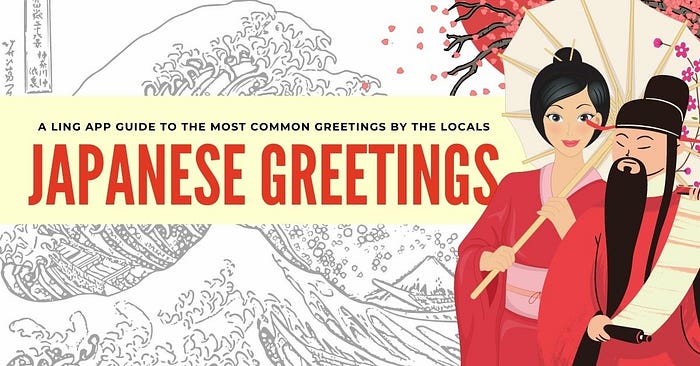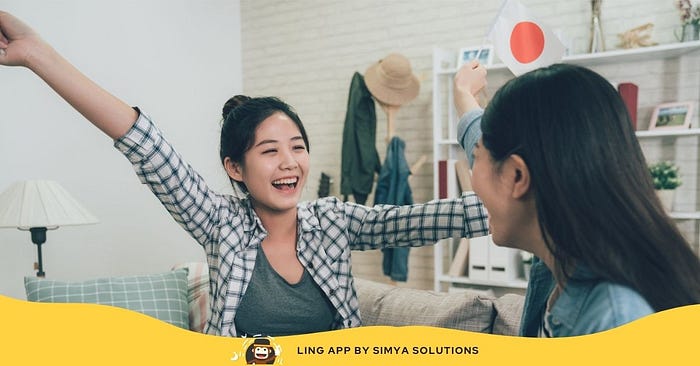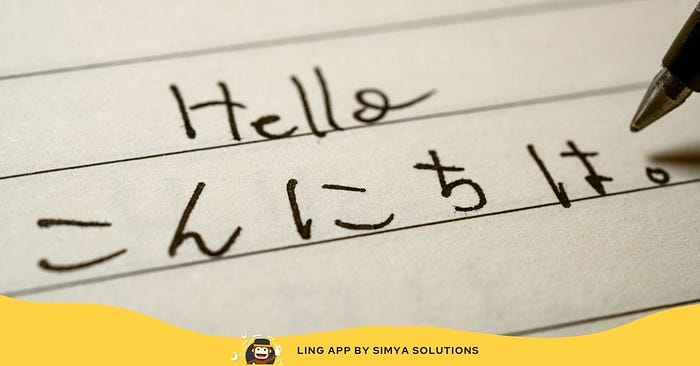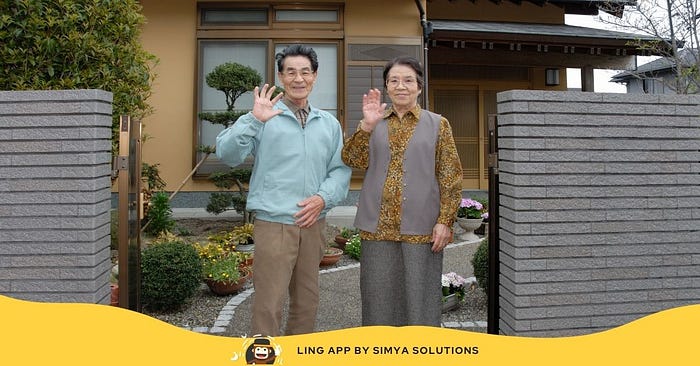15+ Basic Greetings In Japanese You Must Know Now
Original blog post: https://ling-app.com/ja/greetings-in-japanese/

Learning the basic greetings in Japanese language can help you become friends with the locals in the country. While 日本語 or Nihongo is only spoken in Japan, you might be surprised to know that millions from across the world are interested in mastering this Asian language. In fact, recent studies show that the number of institutions for this language is rising, making it part of the 25 most spoken languages in the world! So start learning the casual and formal greetings today in this post.
There is no denying that Japanese is a language that is pretty difficult to learn, especially for Westerners. One of the main reasons behind that is because it has three writing systems that are sometimes used simultaneously in written documents. This includes Hiragana (平仮名) for phonetic spelling, Katakana (カタカナ) for foreign words, and Kanji (漢字) which represents whole words adapted from Chinese characters. If this is your first time getting lessons in Japanese, we recommend that you start by familiarizing the basic Japanese greetings to help you grasp the pronunciation and the letters used.
10 Ways To Say Hello In Japanese
If the French people like giving cheek kisses to greet someone, the Japanese do this by bowing at a certain angle and duration. And when we say bowing, we do not mean a simple nod! The Japanese culture reflects that the locals do the ojigi (お辞儀) because it shows respect and willingness to lower yourself in a vulnerable position in front of the other person. Please note that you are also expected to do this even if you are a foreigner just traveling to the country.
There are three types of bows that you can do while saying your Japanese greetings, and this includes:
- Eshaku (会釈) — 15 degrees of bow used for informal interactions with strangers or close friends.
- Keirei (敬礼) — 30 degrees of bow mainly used for business situations and when meeting people for the first time. This is also perfect to use when saying hello to your bosses or when you want to welcome customers.
- Saikeirei (最敬礼) — a 45-degree type of bow used for saying sorry or showing guilt. This can also be used for greeting high-ranking government officials.
こんにちは — Konnichiwa
Whenever we think about the best Japanese word to say hello, most of us always think of the konnichi wa. However, this is actually not used when you are greeting a friend or someone close to you. This is considered a formal greeting used in the office and is more appropriate during the afternoon.
おす — Osu!
In English, people can call you “bro…” but in Japanese, Osu is the word that is somewhat the same as that. If you are a guy who is looking for a trendier way of greeting your close brothers, then osu is the right word to use. This does not have a direct translation related to any greeting, but the locals know this to be informal and used only by the teens or in anime.
お元気ですか — O genki desu ka?
Sometimes, saying hello does not really mean that you translate the word directly in Japanese. For example, if you want to strike a conversation, you can simply ask o genki desu ka, which means “how are you?” in English. The common response for this is げんき です or genki desuwhich means “I am fine.”
やあ/ よ — Ya / Yo
There are simple greetings that are usually used informally between friends and some close coworkers. This somehow is the same with the basic Oi in Portuguese or the Alo in Vietnamese. These can also be used when speaking with strangers who are younger than you.
おはよう ご ざ い ます- Ohayō gozaimasu
If you want to say good morning to another person, you can simply say the ohayō gozaimasu or ohayō to sound more native. This is a simple way to greet someone and can be used in both formal and informal situations, making it a safe word to learn. Please note that some locals may sometimes have variations in how they pronounce this word, but you do not have to worry since the meaning stays the same.
こんばんは — Konbanwa
If you want to say hello or greet someone good evening, you can use this polite word to almost anyone as this is considered the most common form. If you are going to break down its literal meaning, the characters can be directly translated to “this evening.”
おやすみなさい — Oyasumi nasai
If you want to greet someone with a parting phrase, then the most common Japanese expression to use is Oyasuminasai which means “go take a rest.”
ヤッホ — Ya ho!
This is greeting is usually used between kids, and you probably have heard of this on animes where the characters try to get attention. This is like the basic Yahoo! in English and is seen by the locals as a bit feminine.
調子はどうですか — Choushi wa dōdesu ka
This is also a question that can be used as a greeting and a conversation starter. This can be directly translated to “how is it going?” and is safe to be used for both formal and informal situations.
もしもし — Moshi moshi
Among all the common Japanese greetings in this list, the best one you can use for greeting when answer the phone is moshi moshi. However, please note that this expression is better to use when you know that the one calling you is a family member, relative, or close friend.
7 Japanese Greetings At Home

If you plan to join a homestay program where you will share a home with a Japanese family, it would be wise to learn all the typical phrases and greetings that you might hear from the locals. Whether they are at work or home, the Japanese culture puts a premium on respect and etiquette, and this is the reason why you need to at least familiarize yourself with the ones listed below.
If ever you get invited to a Japanese home, please do remember that you should start greeting the family with the basic greetings like こんにちは(Konnichiwa) accompanied by a 30-degree angle bow, especially if you are speaking with the older people. After saying that, you must also say お邪魔します (Ojamashimasu), which is a formal greeting that means “excuse me for disturbing.” Also, greet the host directly and give him or her the 手土産 (Temiyage) or a small gift which is important in their culture as it shows your thankfulness for being invited. Any gift will do, but the most common form is food, tea, or anything that can be consumed.


4 Formal Greetings In Japanese For The Workplace

As you probably noticed from the section above, Japanese people are keen on exchanging gifts. Therefore, if you are moving to Japan to start a new role in a company or public office, it would be wise to bring お土産 (Omiyage) from your home country. An Omiyage is basically a souvenir. Even if you are traveling to another part of Japan, the locals have a burning desire to bring gifts to their family, friends, classmates (if you are a student), and colleagues at work. The Omiyage are usually edible gifts too that are wrapped individually and are given face to face.
As for the working culture, the Japanese are known in the world to be some of the most hardworking people in the office. Therefore, there are times wherein they sometimes have to work overtime, and if you are planning to go home ahead of them, do note the greetings and polite Japanese phrases you can use.

Basic Goodbye Greetings

If you have watched a good number of animes and Japanese films, then you know that the most common poetic form of goodbye is さようなら or Sayonara. While the media rampantly use this, it actually is not the best way to say goodbye like a native speaker. In fact, an incorrect tone can even lead to awkwardness since most Japanese believe that this is like saying goodbye forever. If you want to learn the more acceptable versions for saying this greeting, read our translations below.

As we reach this part of the post, we hope that you were able to learn Japanese greetings that are more natural sounding than those you can come across in the movies. If you enjoyed this post and would love to master other ways to greet someone, then be sure to check out our previous posts like how to greet in Latvian, Tagalog, and Spanish languages.
Interested In Learning Japanese The Right Way?

Whether you are looking to master the casual or formal way of speaking, learning using the Ling App can be your best option! Aside from the fact that it is available for free online, this language learning application is developed by real native speakers and highly-vetted language specialists from across the globe. From the inside, you’ll get instant access to language lessons perfect for different situations making it an ideal tool may you be a student, a constant traveler, or a professional.
What makes this Ling App interesting is that it takes on a holistic approach which means that using it for at least 10 minutes a day can help you improve in all aspects of language learning — from reading, writing to speaking. This app got you covered! So, what are you waiting for? Download this app on Google Play and AppStore and start sounding more natural in Japanese!
